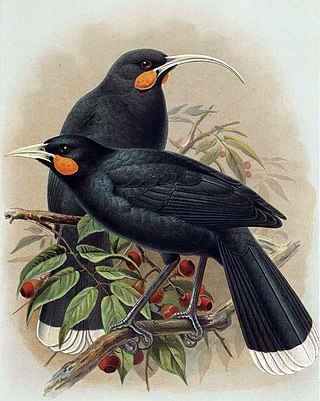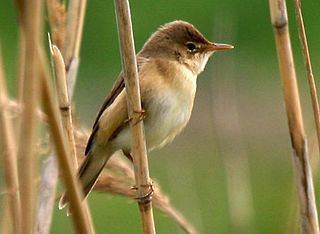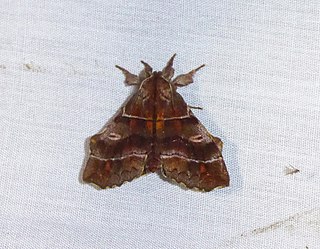
Callaeidae is a family of passerine birds endemic to New Zealand. It contains three genera, with five species in the family. One species, the huia, became extinct early in the 20th century, while the South Island kōkako is critically endangered and may be extinct.

The orthopteran family Rhaphidophoridae of the suborder Ensifera has a worldwide distribution. Common names for these insects include cave crickets, camel crickets, spider crickets, and sand treaders. Those occurring in New Zealand are typically referred to as jumping or cave wētā. Most are found in forest environments or within caves, animal burrows, cellars, under stones, or in wood or similar environments. All species are flightless and nocturnal, usually with long antennae and legs. More than 500 species of Rhaphidophoridae are described.

The common reed warbler is an Old World warbler in the genus Acrocephalus. It breeds across Europe into the temperate western Palaearctic where it is migratory, wintering in sub-Saharan Africa. It is also a resident species over large parts of Africa.

Metanephrops challengeri is a species of slim, pink lobster that lives around the coast of New Zealand. It is typically 13–18 cm (5–7 in) long and weighs around 100 g (3.5 oz). The carapace and abdomen are smooth, and adults are white with pink and brown markings and a conspicuous pair of long, slim claws. M. challengeri lives in burrows at depths of 140–640 m (460–2,100 ft) in a variety of sediments. Although individuals can live for up to 15 years, the species shows low fecundity, where small numbers of larvae hatch at an advanced stage.

The Tephritidae are one of two fly families referred to as fruit flies, the other family being the Drosophilidae. The family Tephritidae does not include the biological model organisms of the genus Drosophila, which is often called the "common fruit fly". Nearly 5,000 described species of tephritid fruit fly are categorized in almost 500 genera of the Tephritidae. Description, recategorization, and genetic analyses are constantly changing the taxonomy of this family. To distinguish them from the Drosophilidae, the Tephritidae are sometimes called peacock flies, in reference to their elaborate and colorful markings. The name comes from the Greek τεφρος, tephros, meaning "ash grey". They are found in all the biogeographic realms.

Rhopalosomatidae is a family of Hymenoptera containing about 68 extant species in four genera that are found worldwide. Three fossil genera are known.
Jean-Jacques Kieffer was a French naturalist and entomologist who specialised in the study of parasitic insects. Educated as a priest, Kieffer taught natural science in Bitche, Lorraine while working on the description and classification of insects. His work and publications later became a predominant source of description and classification for entomologists in the early 20th century, in particular with regard to parasitoid wasps, midges, and mosquitos.

Brahmaea is a genus of moths of the family Brahmaeidae. Acanthobrahmaea, Brahmidia, and Brachygnatha are synonyms. Acanthobrahmaea has sometimes been considered a subgenus, describing an endemic relict species that only occurs in the vicinity of the Monte Vulture in Italy.

Ischalis is a genus of moths in the family Geometridae. The genus was erected by Francis Walker in 1863. All species within this genus are endemic to New Zealand.
Ephoria is a genus of moths of the family Apatelodidae. It was previously known as Colabata, as a result of Herrich-Schäffer's Synopsis familiarum Lepidopterorum—in which Ephoria was introduced—having been published twice. The earlier of these publications precedes that of Walker's Colabata in 1856, making the latter the junior synonym.

Prothysana is a genus of moths of the family Apatelodidae. It contains two species, whose larvae are known as shag-carpet caterpillars. They are found from Mexico, south to Panama and into South America, at least to Ecuador.

Zanola is a genus of moths in the family Apatelodidae.

Maaminga is a genus of parasitic wasps containing two species and constituting the family Maamingidae. So far only known from New Zealand, the two named species are Maaminga marrisi and M. rangi. The genus name derives from the Māori word "māminga", simply translated as "trickster" as the species evaded discovery for so long.

Dame Carolyn Waugh Burns is a New Zealand ecologist specialising in lakes. She is an emeritus professor at the University of Otago.
Ismaridae is a family of insects belonging to the order Hymenoptera. About 50 species are known in this small relictual group; all the species for which the biology is known appear to be hyperparasitoids that parasitize Dryinidae.

Neurogalesus carinatus is a species of parasitic wasp in the family Diapriidae, first described in 1907. It uses the Australian soldier fly Inopus rubriceps as a host, sharing its range in pastured areas of South East Queensland, northern New South Wales and its non-native range on the North Island of New Zealand.
Gwaihiria is a genus of wasps belonging to the family Diapriidae.
Pantelodes is a genus of moths of the family Apatelodidae. It was first described by Daniel Herbin in 2017, containing at the time nine species: Pantelodes satellitia and eight newly described species previously identified as the former. In 2021, an additional species, Pantelodes camacana, was described. The distribution of the genus is Neotropical.

Maoripria earlyi is a species of parasitoid wasps in the family Diapriidae. It was first described by Australian entomologist Ian D. Naumann in 1988.

Ambositrinae is a subfamily of parasitoid wasps, within Diapriidae. The subfamily was first described by Canadian entomologist Lubomir Masner in 1961. Most species have a Gondwanan distribution, being found in Australia, New Guinea, New Zealand and South America.














